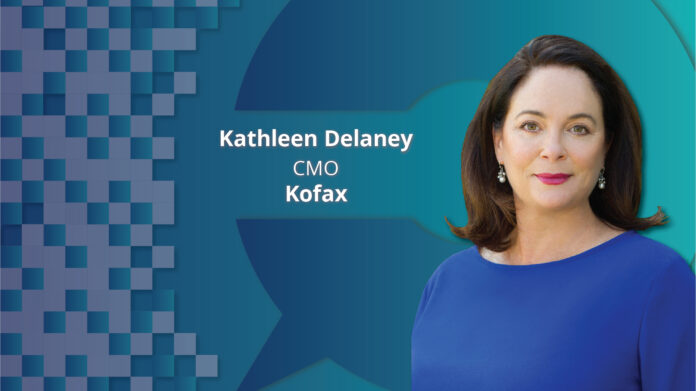It is important for CMOs to understand and study the entirety of the customer (and prospect) journey with their organization, says Kathleen Delaney, Chief Marketing Officer, Kofax, in an exclusive interview with TalkCMO.
TCMO Bureau: What are the uncommon business strategy points many CMOs miss?
Kathleen Delaney: It is important for CMOs to understand and study the entirety of the customer (and prospect) journey with their organization. Little things can be huge drivers of dissatisfaction and impact everything from demand generation to sales and subsequent renewals.
The CMO is in a position to identify and then ultimately work across the organization to improve those key business workflows and drive success in the organization. Naturally, many of these business workflows are ripe for automation – customer onboarding, invoicing, and proprietary workflows.
Read More: Strategies to Measure Consumer Attention in Advertising
TCMO Bureau: How effective do you feel digital marketing to be to create an effective sales funnel?
Kathleen Delaney: It is an essential component of a healthy demand generation program. CMOs can do it well by using the incredible thought-leadership and customer success stories as the backbone for calls to action (CTAs) and combine that with investments made around intent-based marketing. With limited budgets, one needs to be laser-focused on the prospects. Digital marketing is one of the very effective tools a brand can have in their arsenal.
TCMO Bureau: With increasing changes in customer behavior trends after the pandemic, what kind of shortcomings do CMOs face now?
Kathleen Delaney: CMOs need to be creative, that’s for sure. I know many are lamenting the loss of in-person events and Zoom/webinar fatigue is very real after a year of COVID-19. Add in regulatory challenges, GDPR and CCPA for instance, getting in front of new prospects can be challenging.
Focusing on accounts and use-cases where companies drive value can be very relevant when brands get the time and attention of prospects. Customer engagement will increase with business development team and in webinars. The conversation rate will increase over video, and prospects will take more videos as part of their buyers’ journey. Hybrid online/offline event programs can also be explored to continue to maximize on this engagement.
TCMO Bureau: How do organizations embrace the low-risk approach and drive revenue through digital marketing?
Kathleen Delaney: First, the organization’s website is their most digital channel. Many are still designed and executed as if they are little more than online brochures, which is an out-dated strategy. An optimized website should be designed as the organization’s brand awareness and lead-generation powerhouse.
Every element should be thought through, including the customer journey, speed-to-lead, content marketing, ease of use, modern storytelling, and of course, SEO. With an exceptionally designed website, organic traffic and lead generation should be very low cost. Couple that with paid programs focused on brand/awareness, intent and the ideal customer and brands can have a very efficient and resourced digital program. And again, the beauty of this strategy is that everything can be measured and evaluated, which drives credibility of the marketing function within an organization.
TCMO Bureau: What kind of marketing strategies do you see to be profitable in the near future?
Kathleen Delaney: Today, prospects spend more than 70 percent of their buyers’ journey in the dark funnel or “anonymous” to marketing and sales. By the time a prospect has completed a form, sent an RFP, or interacted with a chatbot, the buyer is likely to consider multiple suppliers.
Marketing and sales need accounts fitting ideal customer profile, understand their research behavior, and develop a customized audience engagement program to capture this demand. Based on this model, the right messages at the right time should be deployed to accounts that will likely convert the highest. Brands can convert search budget to an account-based marketing and anticipate a higher ROI based on the same level of budget.
Read More: Marketing Mindset: The Ingredient to Successfully Implementing Digital Transformation
But ultimately, what strategy is profitable completely depends on the maturity of the business and the KPIs that have been set up. A startup that wants to establish itself in a new market is clearly different from an established brand in a mature market. With clear key performance indicators (KPIs), marketing strategies can be applied appropriately. At its heart, marketing is a data exercise/operation – one can measure just about everything.
As go-to-market realities continue to evolve, marketing increasingly has tools and intelligence to drive growth across the spectrum from startups to Fortune 500 companies. So, it is crucial to invest in the infrastructure and tools to ensure that CMOs can measure what they do. I know it’s hard to take the hard-earned marketing budget and use it for infrastructure, but in the long run, it is the only way to know that whatever strategy is deployed, it is profitable.
As Kofax CMO,Kathleen Delaney is responsible for all global marketing functions including product marketing, demand generation, digital marketing, social media, marketing operations, events, and public and analyst relations. Prior to joining Kofax, she served as CMO at HireRight and Vistage Worldwide. She has held executive level marketing roles at a number of major companies in the financial and risk management industry







